
Ariocarpus is a small genus of succulent, subtropical plants of the family Cactaceae.

Talinum paniculatum is a succulent subshrub in the family Talinaceae that is native to much of North and South America, and the Caribbean countries. It is commonly known as fameflower, Jewels-of-Opar, or pink baby's-breath.

In botany, succulent plants, also known as succulents, are plants with parts that are thickened, fleshy, and engorged, usually to retain water in arid climates or soil conditions. The word succulent comes from the Latin word sucus, meaning "juice" or "sap".

Jatropha cathartica is a species of flowering plant in the spurge family, Euphorbiaceae, that is native to Texas in the United States and Coahuila, Nuevo León and Tamaulipas in northeastern Mexico. Common names include jicamilla (Spanish) and Berlandier's nettlespurge.

Euphorbia mammillaris is a plant species endemic to Cape Province of South Africa. Euphorbia mammillaris, also known as Indian Corn Cob, is a fast-growing shrublet with thick stems that are chalky green, erect and ribbed. The varigata form has stems that turn rosy pink in colder weather. At maturity, the plant can reach 8-10 inches tall. Each stem can have from 7 to 17 ribs with thick hexagonal tubercles placed next to each other vertically, which resembles the look of a corn cob. The spines are pinkish white, thick and pointy like toothpicks, up to 0.4 inches long and scattered around the stem. From late winter to early summer, Euphorbia mammillaris variegata produces small red and orange flowers from each stem.

Aloe humilis, also known as spider aloe is a species of succulent plant in the genus Aloe. It is endemic to South Africa's Cape Province, and is a low growing, short stemmed aloe with small spines and which grows in dense clusters.
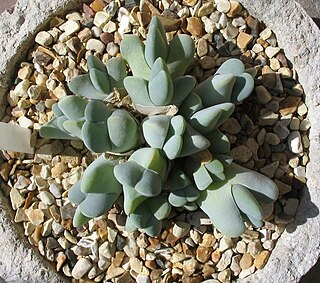
Cheiridopsis pillansii is a species of plant in the genus Cheiridopsis native to South Africa. It is a low-growing succulent with pairs of small, cushion-like leaves that are pale green to purple in color. C. pillansii, sometimes commonly called the "hoof mesemb", forms clumps up to 500 millimetres (20 in) wide.
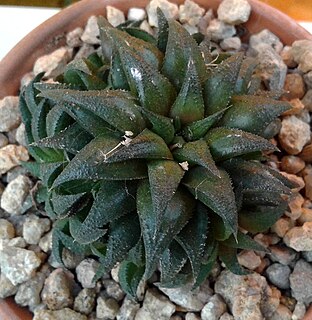
Haworthia parksiana is a species of succulent plant native to the Cape Province of South Africa. Regarded as the smallest and one of the rarest types of Haworthia in the wild, it is thought to be most closely related to Haworthia floribunda. It grows in rosettes that offset, and is often hidden in the ground.

Haworthia mutica is a species of succulent plant native to South Africa's Cape Province. Very similar to, and often confused with, types such as Haworthia retusa, the species has blunt, triangular shaped leaves that are typically striated. In the wild it rarely offsets, though clones in cultivation may do so readily. The variety H. mutica var nigra is similar but with darker leaf color.

Haworthia chloracantha is a species of succulent plant native to the Cape Province of South Africa. H. chloracantha has typically pale yellow-green leaves and is somewhat similar to Haworthia reticulata in form, but the leaves are opaque rather than translucent. It forms prolific clusters of plants. The plant has a few subvarieties including var. denticulifera, meaning has small teeth on its leaves, and var. subglauca, which has darker foliage.

Haworthia lockwoodii is a species of succulent plant in the genus Haworthia. Native to the Cape Province of South Africa, it was named for a local magistrate.

Haworthia floribunda is a species of succulent plant in the genus Haworthia native to the Cape Province of South Africa. It grows in rosettes with dark green, lanceolate leaves that curve or twist outward. The leaves may be smooth or, in H. floribunda var dentata, have small teeth.
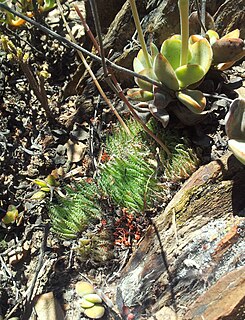
Haworthia herbacea is a species of succulent plant in the genus Haworthia native to the Cape Province of South Africa. Closely related to Haworthia reticulata, it has greenish yellow leaves with small spines. As it matures the leaves get darker green and the white spots raise. Flowers by way of a shoot and produces a large off-white flower.
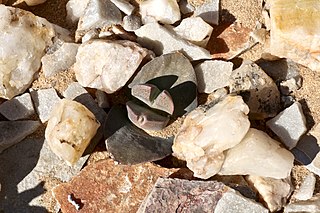
Cheiridopsis peculiaris is a species of succulent plant in the genus Cheiridopsis native to South Africa. Its name refers to the peculiar leaf shape compared to other species in its genus. Like other Cheiridopsis it has leaf pairs, but unusually the outer pair grows flat along the ground while the other pair faces toward the sky.
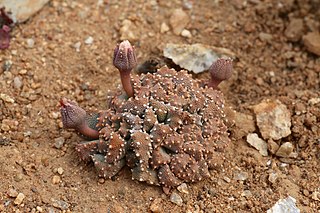
Aloinopsis luckhoffii is a species of succulent plant in the genus Aloinopsis native to South Africa. Like other Aloinopsis it grows in a rosette of leaves close to the ground. It has angular leaves that are covered by small, white tooth-like protrusions.
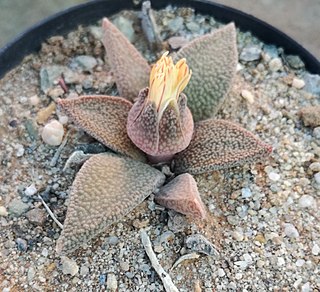
Aloinopsis rubrolineata is a species of succulent plant in the genus Aloinopsis native to South Africa. It grows in a branching habit low to the ground, and has leaves covered with small, round tubercles. The leaves are dark olive green and tongue-like in shape. Its scentific name refers to its flowers, which have a distinctive red stripe.
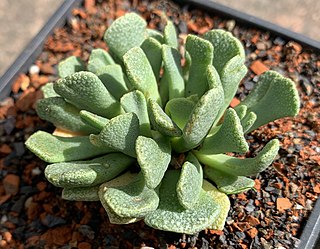
Aloinopsis spathulata is a species of succulent plant in the genus Aloinopsis native to South Africa. It has spoon-shaped green leaves patterned with tubercles, and unlike the yellow flowers of most in its genus, it has magenta to pink blooms. Able to grow in Sutherland, the coldest town in South Africa, it is particularly frost hardy.

Crassula ericoides is a species of succulent plant in the genus Crassula native to South Africa. Growing in the fynbos ecosystem of South Africa, C. ericoides somewhat resembles a heather, growing into an upright shrub with bare lower stems and yellow flowers at the tips.
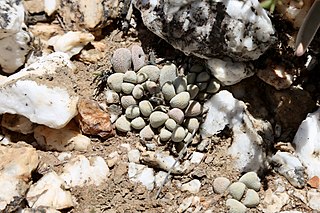
Crassula tecta is a species of succulent plant in the genus Crassula native to South Africa. Easily confused with Crassula namaquensis, this species has a compact growth habit forming clusters of round, blue-white leaves. Kept in cultivation since the 18th century, Crassula tecta is known for the beautiful patterning on its leaves and white flowers.
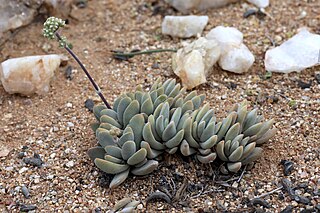
Crassula namaquensis is a species of succulent plant in the genus Crassula native to South Africa. Easily confused with some forms of Crassula tecta and Crassula sericea, this species has rounded to elongated leaves that are usually blue, covered in fine hairs, and form clumps.




















